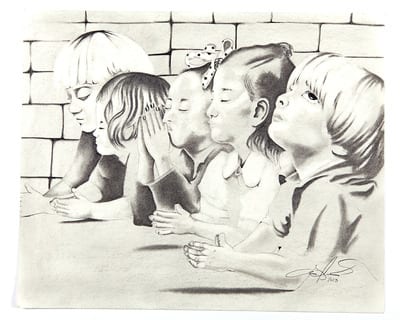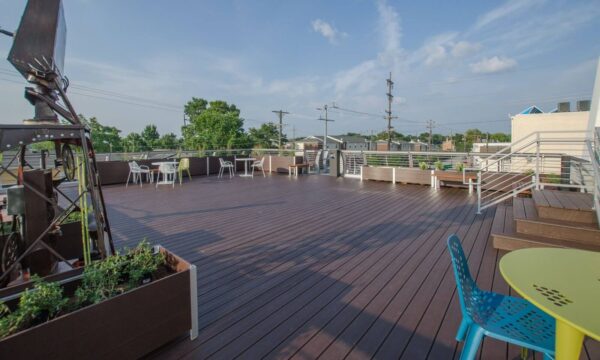POVERTY & THE ARTS is awesome. Here’s why: their goal is to empower homeless and formerly homeless individuals as artists and creatives by helping them generate income, job skills, security networks, and purpose in life. They also use the arts to promote relationships and a space for volunteers to view homeless individuals as talented and creative, thus creating better advocates and more compassionate community members. Over the past few months, we’ve been displaying pieces from the organization in our Center 615 Main building. We sat down for a Q&A with Nicole Brandt, the brains and heart behind Poverty & the Arts.
Tell us the story behind Poverty and the Arts?
Growing up, the narratives told to me about homelessness were that the individuals were lazy, worthless, drug addicts that didn’t deserve the money of the government or its people. My senior year of high school, through the relationship of my best friend’s bus driver, I began spending time with homeless people in their camps. My first real experience with the homeless wasn’t in a soup kitchen or a shelter serving them. My first experience was being invited into their space, being a guest in their “home”. I learned that the individuals I fell in love with were not lazy or worthless. In fact, they were creative and resourceful–yet victims in the systematic and structural systems of oppression: poverty, racism, and mental illness. When I moved to Nashville 4 years ago to attend Belmont University, I wanted to recreate a space where people could genuinely get to know homeless individuals, rather than believing the perpetuating myths surrounding them. I explored what it would look like to use art as the conduit for volunteers to see homeless individuals as equals. We hosted our first Community Arts Day in November of 2011 and both the homeless participants and volunteers asked for weeks about when we would be coming back. The organization grew out of those relationships and people. Today, we host regular Community Arts Days for Nashville’s homeless community at large, and work closely with a small number of homeless artists recommended by the staff of local homeless organizations. Through the support of the community, we are able to provide resources for our artists to generate income through creating and selling artwork.
What would you like people to be more aware of regarding homelessness/poverty?
Solving homelessness is a community effort, and there is an important need to provide services to our homeless population in Nashville. However, our goal is to provide an environment of success for our homeless community so that they can take advantage of the services being offered and make real change in his or her life. We’ve seen that environment drives behavior, so living in the typical homeless environment of chaos, fear, loneliness, anger, and/or addiction is going to drive severely negative behaviors. Oftentimes, the cycle of homelessness and poverty is created by an inability to break this mindset of dependence. Poverty & the Arts’ goal is to offer an environment where homeless individuals can thrive by engaging in creative outlets and building security nets in the creative community. Through our offered arts programming, homeless individuals are able to develop not only confidence and determination, but also income-generating opportunities as well as job skills and preparation. The programs are also designed to give volunteers a chance to interact directly with homeless participants in an effort to encourage meaningful conversations and build genuine relationships that are critical in breaking the cycle of homelessness.
What are common misconceptions?
I think there are two big common misconceptions surrounding homelessness. The first is that all the individuals do drugs or are even unemployed. We have a homeless artist in our Artist Collective that’s had a full time job for several months after exiting prison. The second misconception involves those individuals that are addicted to drugs and those that seem like they are choosing homelessness. Experiencing homelessness creates a survival mindset that strips individuals of normal conveniences like privacy, safety, independence, and community. As the homeless environment of fear, dependency, and addiction drives negative behavior, it is up to us as a society to create an alternate environment that provides the homeless individuals an opportunity to actually generate their own success. An ideal environment provides people an opportunity to be creative, to dream, to have relationships with people outside of homelessness, to find purpose, to obtain job preparation skills, and to generate streams of income. People that seem like lost causes often just need a healthier environment to live in day-to-day.
What’s been the best part?
I thought the best part of our program would be the opportunity for our homeless artists to make money through selling their artwork. I learned that while our artists appreciate the opportunity to earn money, the biggest reason they show up every time is for community. We’ve built this environment of trust and encouragement with each other. Our artists want each other to succeed and are a source of light in the otherwise dark day-to-day experiences of homelessness. I love the commitment and effort all of our artists have given to the program and its success. They’ve offered to help with fundraising, construction, outreach, and more! They are just as committed to Poverty & the Arts’ success as I am!
The hardest?
I graduated college in May 2014 with a degree in Religion & the Arts. I had no background in business, marketing, or accounting. I started this nonprofit on a vision, and have been overwhelmed by the support and expertise the Nashville community has offered up. However, dealing with the complicated problems of homelessness at 23 years old, as well as the responsibility of managing a nonprofit, have been extremely difficult.
Why art?
Art is a human experience that allows people to find beauty amidst the difficulties of life. Art also creates a space of equality and allows the Nashville community to see the homeless as creative and talented, versus the typical homeless service opportunities that feel more us versus them.
Cover Image: Elementary Prayers by Ash-Shahid Muhammed




